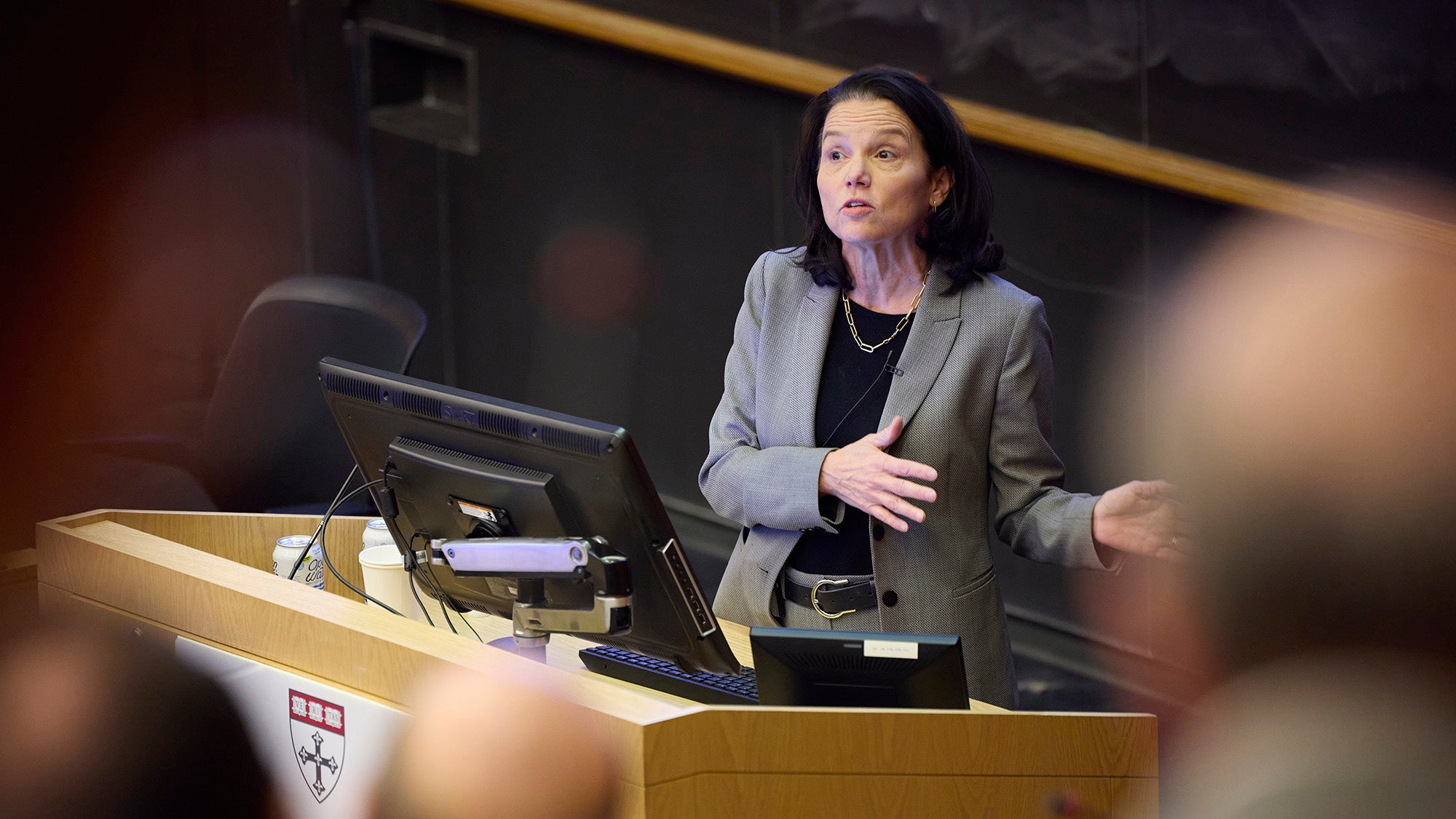Stopping Misinformation: Scientists and Medical Professionals are Important Players in Communicating Reliable Information

In a highly complex information ecosystem, news travels fast. Whether it’s dispersed through traditional news publications, social media, or fringe outlets, the news can get warped. That’s why communicators are trying to find the best ways to share their messaging accurately and promptly.
“A lot of communication of risk is about communicating uncertainty. All knowledge is partial knowledge, and all science is tentative,” says K. “Vish” Viswanath, Program Director of Applied Risk Communication for the 21st Century and Lee Kum Kee Professor of Health Communication in the Department of Social and Behavioral Sciences at Harvard T.H. Chan School of Public Health. “But how do you communicate that to different publics when you want them to take specific actions?”
In a new report from the National Academies of Sciences, Engineering, and Medicine, Viswanath looks at the origins and impacts of misinformation and explains why scientists and medical professionals are important players in communicating reliable information.
What Types of Science Knowledge are We Trying to Share When we Communicate Risk?
Viswanath notes that there are two kinds of scientific knowledge. The first is settled science, which is composed of well-established knowledge. The type of messaging around settled science is stable and changes slowly over time.
“For example, we know lead in water pipes or windows in houses can be dangerous and could potentially lead to adverse cognitive impacts on children,” Viswanath explains.
The second is unsettled science, which applies to situations like COVID-19, where the knowledge is relatively new. The causes and risk factors may change, and the accompanying recommendations also shift.
“That knowledge is evolving,” says Viswanath. “At that point, communicating certain risks becomes a little bit more challenging.”
As a result, unsettled science can lead to significant frustration among people who question why authority figures are frequently changing their ideas about risk factors and the recommendations on how to deal with the disease. While these changes are due to the rapid way science changes, they can leave the public feeling disillusioned.
Why Has Risk Communication Become More Challenging in this Contemporary Information Ecosystem?
It’s not just social media that plays a role in the delicate ecosystem of information. Viswanath notes that popular culture is an important factor in the interpretation of science and risk and has a significant impact. And with the constant onslaught of information that people face, it’s likely overwhelming. When you consider the diverse range of sources of information, which can include everything from movies and celebrities to faith-based organizations and family members, the situation is even more complex.
Viswanath’s research also identifies a large number of reasons misinformation spreads, as well as some potential intervention points regarding how to properly intervene.
Who Needs to Further Their Knowledge?
Specifically designed for professionals who are hoping to gain a greater knowledge of when to intervene to promote more accurate risk information and the diverse ways of going about it, Applied Risk Communication for the 21st Century pulls from diverse career paths.
“The organizations are a very wide range, but the commonality is that they’re all broadly in the risk communication area,” says Viswanath.
Some of these career paths include:
- Professionals who already practice risk communications
- Center for Disease Control employees
- Federal agency employees
- Food and Drug Administration employees
- Nuclear Regulatory Commission employees
- State Health Commission employees involved in regulatory risk communication
- Policymakers
- Senior executives
Viswanath notes that while some professionals who sign up for the course are already practicing risk communication, others simply feel they should be informed about risk communication because they work in a leadership position and know they should have a greater understanding of communicating risk.
“Where do you intervene to promote more accurate risk information?” Vish notes. “And what are some ways of doing it?”
Individuals in trusted professional roles need to be equipped with the proper training and education to manage risk communication. However, with the proper training, these professionals have the skills to design effective risk communication messages and increase trust in their organization.
Harvard T.H. Chan School of Public Health offers Applied Risk Communication for the 21st Century, which provides state-of-the-art knowledge on designing effective risk communication messages to improve communication, increase trust in your organization, reduce public anxiety about an issue, and help key stakeholders make better decisions.
Last Updated
How to Value a Life

The “value of a life” sounds like an existential question, more suited for philosophers and ethicists than economists. Yet we make economic decisions almost every day that reflect the value we each place on reducing our own risk of dying. We might pay more for safer food, for a house in a safer neighborhood, or for a car with added safety features. We might buy protective sports equipment, hand sanitizer, or face masks. The examples are almost endless, according to Lisa Robinson, senior research scientist and deputy director of the Center for Health Decision Science at the Harvard T.H. Chan School of Public Health. Robinson also directs the Harvard Chan School’s online professional development program, Benefit-Cost Analysis: Valuing Life and Health. That program aids those who conduct these analyses and those who use the results in understanding these methods and their implications.
In benefit-cost analysis, the “value of a life” – or more precisely, the “value per statistical life” (VSL) – refers to these day-to-day tradeoffs, although the language is confusing, Robinson explains. Economists use surveys and other data to estimate the monetary value we each place on small changes in our own risks, then aggregate the results to estimate the expected value of averting future deaths. They use a similar approach to estimate the value of averting nonfatal illnesses and injuries. By doing so, they are able to directly compare the monetary value of these and other benefits against the costs of alternative interventions and policies.
Policymakers and other stakeholders find these comparisons crucial for evidence-based decision-making, as illustrated by the requirements of many government agencies and other organizations. Benefit-cost analysis is often used to evaluate approaches for reducing environmental, transportation, occupational, nutritional, behavioral, and other risks, including climate change. It is applied to interventions that may be financed directly by government programs or other organizations, or that may be funded by imposing costs on industry, households, and other entities through regulations or through taxes and subsidies aimed at changing behavior, Robinson adds.
Why Benefit-Cost Analysis?
Robinson points out that benefit-cost analysis is often used to aid in determining how to best allocate scarce resources – labor, materials, and other things that money can buy – in order to achieve the greatest improvements in health and longevity, as well as welfare more generally. Perhaps most importantly, conducting benefit-cost analysis ensures that the impacts of alternative policies are rigorously investigated. Such exploration is essential to avoid unintended or unexpected consequences.
“A benefit-cost analysis is a way of determining what the impact of a policy would be before it’s enacted,” she says. “It forces us to look more closely at the policy in a systematic way and to ask questions that no one might otherwise think to ask.” We may find information that reveals that the policy won’t be effective, or that it will have far more beneficial effects than anticipated.
The Role of the Value per Statistical Life
When it comes to valuing reduced mortality, Robinson says using value per statistical life (VSL) estimates is most appropriate methodology. “Before implementing a new policy, we don’t know whose life that policy might be saved,” she says. “What we do know is that the policy will reduce the risk of dying among those affected.” For example, reducing air pollution in a large metropolitan area will decrease the mortality risks faced by that population. Requiring back-up cameras in cars will reduce the risks of death among those in their proximity.
Usually, the risk changes associated with these policies are very small on an individual level, around 1 in 10,000 or 1 in 100,000, but the number of deaths averted can be quite large when the policy affects a sizable population. For example, a policy that reduces the annual risk of death by 1 in 10,000 among the 4 million residents of Los Angeles would avert 400 deaths per year.
In the U.S., research on individuals’ willingness to exchange their own money for a change in the risk they would experience suggests that on average a U.S. resident is willing to pay about $1,200 for a 1 in 10,000 reduction in their own risk – or $12,000,000 when converted to a VSL estimate. So preventing those 400 deaths annually would be valued at $4.8 billion in any given year, suggesting that it may be worth investing a substantial amount to achieve these benefits.
Putting VSL in Proper Context
Despite the importance of these estimates, Robinson points out that this concept is often misunderstood. Many incorrectly believe VSL refers to the value of saving an individual’s life—how much their life is deemed to be truly worth in a moral or ethical sense. But in fact it is derived from how much that individual is likely to pay to reduce their own risk of dying by a small amount. Not surprisingly, this willingness to pay likely varies depending on the characteristics of the individual, such as their age and income, as well as the characteristics of the risk, such as whether it is caused by something outside of their own control or whether it involves significant pain and suffering prior to death. Estimating the effects of these factors can be difficult. Nonetheless, Robinson says that getting as close as possible to the appropriate value is essential for informed decisions.
Weighing the Costs and Benefits
This brings Robinson to an example. “Let’s say a government agency is thinking about a new requirement that will cost $400 million per year, and is expected to reduce annual deaths by 200. With a VSL of $12 million, the costs are clearly exceeded by the benefits. But if the costs were instead $4 billion, the policy would no longer be cost-beneficial. By understanding this early in the process, policymakers can consider whether alternative policies are worth pursuing, given the likelihood that the benefits will exceed the costs.
“Remember, if we spend money for one thing, we can’t spend that money on something else,” she says. Therefore, it’s essential that we invest limited resources wisely, weighing the costs and benefits to identify the policies that lead to the greatest improvement in wellbeing.
Harvard T.H. Chan School of Public Health offers Benefit-Cost Analysis: Valuing Life and Health, an online program that teaches the advantages and limitations of this method, and improves your ability to evaluate the results.
Sources:
Robinson, Lisa A. Deputy Director, Center for Health Decision Science, Harvard T.H. Chan School of Public Health, Zoom interview April 2024 and follow-up May 2024.
Rising global temperatures are threatening our health—but there are reasons to be hopeful News. (2023, May 17). http://www.hsph.harvard.edu/news/?p=111354859339
Last Updated
The Importance of Getting the Message Right in Your Risk Communication Strategy

Over the past few years, traditional and online news outlets and social media channels have been filled with information about COVID-19—and much of it has been misleading, inaccurate, or incomplete. This has made it challenging for members of the public to make educated decisions about how to protect their own health: from deciding whether to get a vaccine or booster or when and where to wear masks, to weighing the risks of gathering in crowds, according to Kasisomayajula “Vish” Viswanath, PhD, Lee Kum Kee Professor of Health Communication in the Department of Social and Behavioral Sciences at the Harvard T.H. Chan School of Public Health (HSPH). Viswanath also serves as Program Director of the Havard Chan School’s Applied Risk Communication for the 21st Century, an online program that equips participants with the knowledge and skills needed to design effective risk communication messages that can guide them through a public health crisis.
The Need to Refocus Public Health Messaging on the Successes
Viswanath points out that throughout the pandemic, some of the major news coverage has missed an essential part of the story by focusing on the failures that have occurred without also celebrating the many successes.
“If you look at the data, the public is smarter than we think. [In the midst of COVID-19], many people were wearing masks, and didn’t go into restaurants, workplaces, or public places,” Viswanath explains. Nonetheless, both the mainstream and alternative news coverages have been focused on the minority of people who defied the recommendations or had differing opinions. For example, there have been many stories of people who refuse to get vaccinated, rather than those who have gotten the vaccine and booster(s). Yet more than 67 percent of people in the U.S. are now vaccinated, even though the unvaccinated minority get the lion’s share of publicity, he says. “By focusing on what we didn’t accomplish—rather than on what we did—we are actually sending the wrong message to the community,” he stresses.
Exploring the Current Dynamics
The reason the media tends to focus on the negative is multi-fold. First, Viswanath says that people often have a preconceived idea in their mind and so they focus on the details that back up their case, often using it to fill a political agenda rather than making sure to communicate the most reputable information.
“This may give the impression that fewer people are complying than really are, and therefore, this might discourage others from adopting the latest public health guidelines,” he says. In addition, people who are non-compliant with the COVID-19 recommendations often are much more vocal than their counterparts; as a result, they make their voices heard more easily. Finally, examples of people who are defiant to the recommendations can be viewed as more “interesting” for news outlets to cover than someone who follows the directions and does what is expected.
Looking for the Local Data and Story
“We need a completely different way of looking at the distribution of risk. Instead of only presenting a negative view in the news, we can be much more positive and nuanced when we look at the country’s response to COVID. We as a community need to look at both the successes and the failures in order to move forward,” Viswanath says.
Navigating the Changing Risk Communication Landscape
One challenge we need to recognize when it comes communicating risk in a public health crisis such as COVID-19 is that the science is constantly evolving so the recommendations will continue to change as we learn more, he points out. For instance, at the beginning of the pandemic, much was unknown about COVID-19. Over time, we have gained a deeper understanding of how it spreads and how to treat it. As we learn more, the recommendations continue to shift and may vary from one community to the next, depending on each region’s specific circumstances.
“We can’t expect people to be epidemiologists themselves to be able to get the right information and weigh their risks,” he points out. “We need to be able to help them [to assess their local risk] and to model behavior [such as masking], to help encourage people to keep themselves as safe as possible.” In addition, healthcare professionals and community stakeholders also can take this opportunity to explain to people how evidence evolves so they can truly understand the changing nature of the recommendations.
Tips to Guide Risk Communication Strategies
When developing a risk communication strategy, here are several key principles Viswanath recommends:
- Position yourself as a source of reliable information. You can educate people about the latest details in easy-to-understand language. This requires translating the science into plain English that people without a medical background can understand. Also, be sure your messages have clear action steps so people understand what you need them to do to stay safe or respond to the situation. In addition, collaborate with trusted institutions and organizations to help spread your messages to your target audience.
- Build the trust of the general public. This requires listening to their concerns and addressing them in an upfront manner. Even when the information you are sharing is not what people want to hear, it’s important to be transparent so they will respect you as a reputable source. This also means admitting when you don’t know the answer to all of the questions, and being honest when information changes, and your recommendations change along with it. “We also need the public to know that all knowledge is partial knowledge at this time. We need to accept what we know today and also accept that this will keep changing, so the recommendations and guidelines will also keep changing to keep up with the latest information,” he says.
- Create messages that resonate with your community partners and residents. You need to understand people’s needs and concerns so you can frame public health messages to resonate with them. By making sure your recommendations are relevant to your audience—and are also practical for them to implement—this will increase the likelihood of their making the effort to follow them.
Finally, when shaping public health messaging to communicate risk in a public health crisis, also keep in mind that it’s important not to confuse people with details they don’t need or that are filled with speculation. Just stick to the facts and provide clear, actionable information, Viswanath says. Well-crafted risk communication strategies can be essential to ensuring that people make educated decisions in the midst of complex conditions and environments.
Harvard T.H. Chan School of Public Health offers Applied Risk Communication for the 21st Century, an online program designed to provide you with the knowledge and skills you need to design effective risk communication messages.
Last Updated
Risk Analysis in the COVID-19 Pandemic: Weighing the Cost and Benefits of Vaccines and Masks
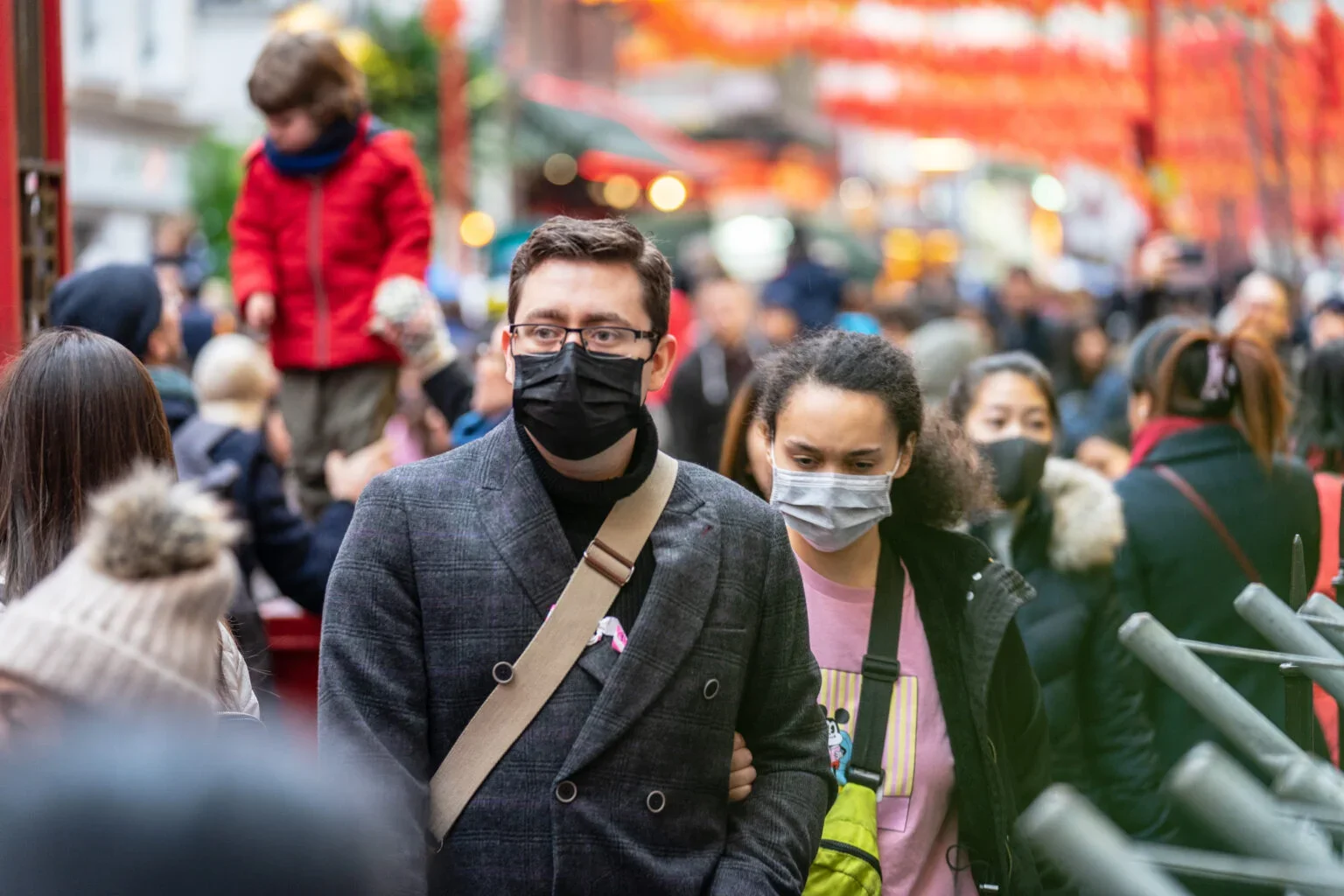
Every single day, people take risks. They drive in cars and fly in airplanes, expose themselves to environmental pollution and so much more. While some of these public health risks are so integrated into our lives that we’ve stopped worrying about them, other risks—such as engaging in activities that increase your likelihood of contracting COVID-19—can be much harder to ignore right now.
Since the onset of the COVID-19 pandemic, considerable attention has focused on how to stop the spread of the disease. This has led to a public divided over whether to follow the recommended guidelines, like wearing a mask or getting a COVID-19 vaccine. Much debate has also ensued over what those guidelines should be and how they should be enforced.
The Value of Risk Analysis
That’s where clinicians, government officials, scientists, public health experts, and the media can play a critical role. According to James K. Hammitt, program director of the former Harvard T.H. Chan School of Public Health program Environmental Health Risk: Analysis and Applications, these parties can help in guiding the conversation and developing best practices and policies that offer the best protection to the public.
In order to effectively address the situation, he suggests people making such public health decisions look to a risk analysis framework to measure the level of threat and to determine how best to respond and communicate the risk to others.
Specifically, you can use this framework to compare the cost of actions like masking with the extent of how that might reduce transmission and save lives. When you weigh these two factors against each other, you can determine if the cost of the action is worth the benefit—in this case, reducing the number of people getting sick and dying.
Understanding Motivation
It’s also important to understand the motivation people have for taking the recommended action, such as getting a vaccine or masking, so you can connect with them from the right perspective.
“For instance, people may care only about the process of getting a vaccine and not the consequences. Or they may care about the consequences—either for themselves or for others,” Hammitt explains. With vaccines, they protect the person who is vaccinated. “People who are vaccinated are less likely to contract COVID-19, and if they do become infected, they are less likely to become very ill or die. With masks on the other hand, it seems clear that they do a lot to help the wearer not infect other people,” he adds.
Yet, he acknowledges that it can be quite challenging to accurately assess risk in the moment. That’s where the science can be a valuable element in any risk assessment equation, where past experiences can help us predict what is coming next.
Measuring Risk and Benefit
“Early on in the pandemic, many people wondered if we were over-reacting to concerns about COVID-19,” Hammitt says. “Initially, there was a report from Imperial College London predicting that there could be more than two million deaths in the United States if we didn’t take steps to avoid this.”. That report was one of several factors that ultimately led the U.S. to implement a variety of lockdowns and social distancing measures.
Now, more than 18 months into the pandemic, the number of deaths total about one-third of the Imperial College London’s prediction. “This leads me to believe we did the right thing. There is no way to know, had we not taken action early in the pandemic, if things would have been much worse and would have reached two million or even more,” Hammitt says.
Yet in September of 2021, COVID-19 was the second leading cause of death in the U.S., according to the Peterson-KFF Health System Tracker. To put this into perspective, he points out that there were fewer than 40,000 deaths caused by car accidents last year, while there have been more than 350,000 COVID deaths so far in 2021. This means that while the current efforts may have significantly reduced the number of deaths, much more work needs to be done.
We need to recognize that we are not going to get out of this pandemic until the world is protected in some way,” Hammitt stresses. “Until then, the disease will keep mutating and threatening our health.
Last Updated
How Do You Communicate Uncertainty and Promote Public Health—During COVID-19 and Beyond?
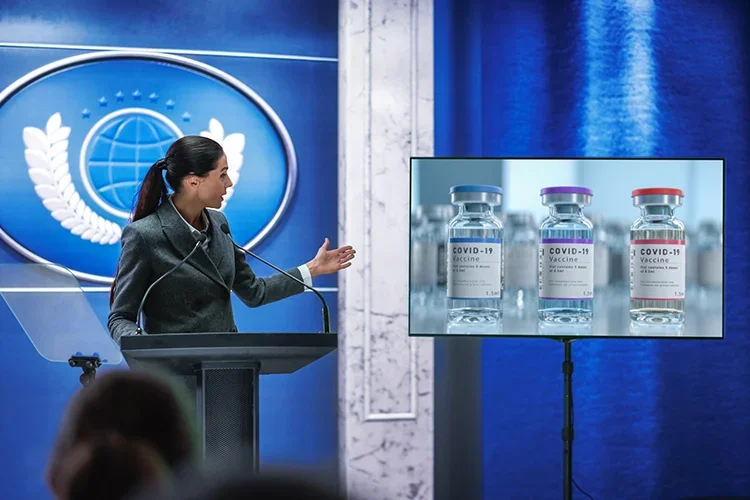
Despite a vast amount of research, there are many aspects of COVID-19 that continue to be perplexing. From the more transmissible variants of the virus to the necessity of mask-wearing after vaccination, the protocols of the pandemic continue to evolve — and inherent uncertainty about the virus will continue. Even when officials delivering information are as accurate as they can be, they might learn something new that makes their previous advice outdated or inaccurate.
Therein lies a core problem of communicating uncertainty around public health information. “What people need to understand is that science is ever-changing and mutable. All knowledge is partial knowledge, and this is an illustration of that,” says Vish Viswanath, PhD, Lee Kum Kee Professor of Health Communication and director of the Applied Risk Communication for the 21st Century program at Harvard T.H. Chan School of Public Health. The members of the public who receive this much-needed information may want facts and certainty, but this may either not be possible or change as knowledge changes.
In the case of COVID-19, many members of the public may be so inundated with potentially contradictory information that it has led to information overload. Viswanath uses the analogy of drinking from the firehose. At this point, he says, there’s a simple question that professionals communicating public health information need to ask themselves: “How do you manage the deluge?”
In other words, how do professionals provide need-to-know information that will help an audience make smart decisions, while remaining a credible source of information and acknowledging that they don’t know everything? How do they communicate facts and uncertainty simultaneously?
What are the sources of uncertainty in science communication?
There are actually two kinds of uncertainty that offer unique and separate challenges. The aforementioned change in knowledge seems easier to convey but can be disconcerting. At the beginning of the pandemic, for example, some public health officials encouraged people to wash any groceries that had been delivered, due to the virus’ potential ability to spread from inanimate objects to humans. Later on, the recommendation changed: washing groceries was no longer deemed necessary, as there didn’t appear to be a correlation between disease spread and unwashed items coming into the home.
This type of uncertainty can be frustrating because individuals who used the recommendation may feel confused and angry. Did they waste their time cleaning their groceries? Why did they integrate the practice into their lives? Were they being lied to? And what should they do now that the recommendation has changed?
Another form of uncertainty occurs when leaders and public figures contest or debate scientific findings in public.
It’s easy to do damage to the credibility of a public health source by sowing the seed of doubt in an audience.
This has the potential to impact large groups of people at a time, since the uncertainty comes from a seemingly trustworthy source, potentially in a public and shareable format. It’s also harder to correct the information once the sources have voiced that perspective. As Viswanath puts it, “When public recommendations are contested, we pay a heavy price for that skepticism.”
Because social media users do not have to abide by journalistic standards, posts can amplify and further distort both types of uncertainty — doing more damage to public health credibility in the process. Misinformation (drawing conclusions based on insufficient or incorrect information) and disinformation (spreading lies to further an agenda) are rampant on social media platforms. The sheer amount of information makes containing false information highly challenging, although efforts are being made by the social media platforms to slow the spread.
Before public health professionals take on uncertainty, they need to understand both forms, identify information people may have already received, and assess how to combat potential resistance to new, accurate information.
Ineffective communication strategies in disclosing uncertainty in science and public health
As has become common during the pandemic, even reputable sources of information have relied on fear and guilt to incentivize behavior. Such tactics could include TV footage of overcrowded hospitals or morgues, or graphic descriptions of ill or dying people who contracted COVID-19.
This tactic is not always effective, according to Viswanath, because it’s more likely to make an audience more resistant to the information.
Attempting to denigrate audience members only serves to alienate them further.
In a similar way, talking down to an audience as if they’re stupid will result in their failure to listen.
Another common mistake is making the advice too general, and not tailored to a particular audience. Aside from the obvious problem that it makes an audience less likely to listen to advice if they don’t feel it applies to them, this mistake has a deeper resonance in the midst of a pandemic that has disproportionately affected people of color and other marginalized groups.
Different communities might need different messages: that they can trust medical professionals and the vaccine, for example, or that they have access to a vaccination site that’s close to where they work. Understanding an audience’s locations and perspectives means that one can customize a communications strategy for groups that have suffered more than others and may have diminished access to information or treatment.
“When we communicate science without openly acknowledging issues of ethnicity, race, place, and class, it impacts people negatively,” says Viswanath. “If we don’t have active awareness of these issues, our strategies will increase those inequalities. We need to get the right groups at the table.”
What are effective communication strategies in disclosing uncertainty around science, research, and public health?
There are two levels of effective communication for any type of critical public health information, and particularly when the information includes uncertainty. Information needs to be assessed at both the systems level and the message level, and each requires its own strategy:
- Systems-level:
- How do you engage with key leaders in the community?
- How do you allow them to provide feedback on the information and how to communicate it?
- What should be the process to roll out information?
- How does this rollout instill trust and likelihood of adopting changes?
- Message level:
- What do you say?
- How do you say it? What are the elements of message construction? How do you construct facts to be clear, concise, and honest?
- Where do you say it — what methods of communication do you use?
- What are the audiences? Are they active or indifferent consumers of information? Do they have science literacy?
- How do you tailor your message so that it reaches and is optimized for each audience?
- How do you address backlash, mis-, and disinformation?
To communicate uncertainty effectively, especially in a crisis, Viswanath offers a few more ways to customize information. When there is information overload and changing recommendations, the message for the audience needs to narrow.
What is important to their regular, everyday existence right now? Envision this audience question: “What do I need to do so I can live my life with some degree of certainty and safety?” and seek to answer it. Anything outside of this information, though it may be important, should take a backseat to need-to-know information.
Additionally, Viswanath explains, public health professionals need to operate from a place of total and utter transparency. When you don’t know something, or it’s unclear, say so. “Audience members won’t be happy if you don’t know everything, but they’ll appreciate that you’re being completely open with them,” he says. This might be challenging, and might lead to backlash, but it’s the only way to maintain long-standing trust. “It’s not about us. It’s about understanding what the challenges are in their lives. Our message should solve their problems.”
Harvard T.H. Chan School of Public Health offers Applied Risk Communication for the 21st Century , an online program designed to provide you with the knowledge and skills you need to design effective risk communication messages..
Last Updated
Developing Public Health Communication Strategies—And Combating Misinformation—During COVID-19
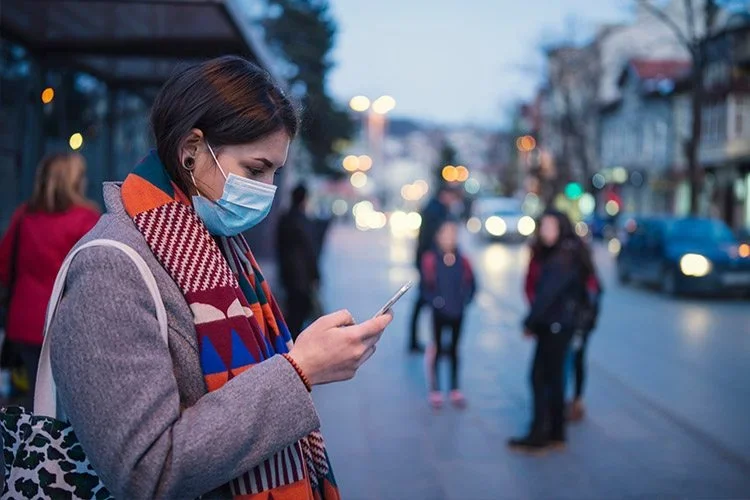
The coronavirus (COVID-19) pandemic continues to spread across the United States and the world. It is an unprecedented time—among other directives, people in affected areas have been asked to limit contact with others except when necessary (also known as social distancing), which has drastically impacted business, education, and daily life. The effects of the virus change every day, and some states have gone so far as to ask that residents shelter in place and not leave the house unless absolutely necessary.
The amount and nature of information available to the public is changing and evolving constantly. COVID-19 originated in China and has spread across the world, but data are still being collected about cases in the United States. The flood of information, both reliable and unreliable, has only served to make effective communication harder. So what needs to be done?
How the Coronavirus Pandemic Is Different
COVID-19 is unlike previous medical crises, in part because of our collective access to communication technologies. “This is the first pandemic of its kind in the age of social media,” explains K. Vish Viswanath, Lee Kum Kee Professor of Health Communication and director of the Applied Risk Communication for the 21st Century program at the Harvard T.H. Chan School of Public Health. “We have proved, as a system, singularly unprepared to handle this aspect.”
“Because of the saturated information environment, we are getting overwhelmed, even though each medium is covering information in a careful and responsible way, especially the mainstream press,” he explains. “The collective exposure is causing stress. People are struggling with how to stem the tide of information flooding them.”
Unlike journalists, public health officials, and other “gatekeepers” of information, people on social media don’t necessarily have to abide by strict standards of fact-finding. Viswanath says he’s seeing both misinformation (drawing conclusions from wrong or impartial information) and disinformation (deliberately spreading falsehoods to further an agenda) about COVID-19.
This is the first pandemic of its kind in the age of social media. We have proved, as a system, singularly unprepared to handle this aspect.
COVID-19: Misinformation vs. Disinformation
Misinformation can stem from our knowledge gaps: not yet having a full understanding of the virus and our seeming inability to act beyond staying at home. “There’s no cure, no vaccination—people lose their sense of agency, so they try to fill that gap,” explains Viswanath. Speculation may be rampant as a result, and it’s not based in full factual analysis.
Disinformation is more insidious, with certain groups trying to sow seeds of distrust towards institutions. According to Viswanath, “Public health communications operate on the principles of transparency, reliability, and trust. If you can do damage to any of the principles, it can have potentially devastating consequences.”
Spreading what amounts to conspiracy theories can have the impact of making people cynical and less likely to comply with official recommendations, which are especially necessary right now. Some politicians, according to Viswanath, are not helping matters. Spreading false or misleading information as truth will leave memory traces in an audience, even when the information is later proven to be false.
Public health communications operate on the principles of transparency, reliability, and trust.
What an Organization Can Do to Deliver COVID-19 Information
“This won’t be the last pandemic,” says Viswanath. Thus, organizations need to have a robust communications surveillance strategy in place for future crises. Ultimately, there are a few ways professionals conveying formal recommendations can develop and maintain trust:
- Understanding their audiences (class, age, risk, communication style) and tailoring the message to reach them. This might mean using platforms like social media to impart facts and resources.
- Communicating uncertainty clearly—saying that not all information is available is more effective than speculating or making claims.
- Not over- or under-reassuring, but simply laying out risk and potential consequences with the appropriate tone.
- Providing numbers, context, history, and changes to procedure in a timely and straightforward fashion, which can help bolster trust.
- Telling people what they can do and how they can act to keep themselves and others safe.
- Watching social media: understanding what questions and knowledge gaps are coming up and strategizing how to counter myths and threats actively.
In the case of COVID-19 specifically, more information needs to focus on the spread of the virus, the risks associated with contracting it, and why people should comply with the recommendations even if the number of cases are low where they are. Particularly with COVID-19, not enough people understand the reason for social distancing is to prevent disease spread even if the disease will be mild in their case or if their relative risk is low.
Additionally, the word “pandemic” is already a frightening concept that can make an audience feel powerless, so increasing their agency is another important strategy right now. “People are already experiencing the crisis—there’s no point in sugar-coating the current situation,” says Viswanath. “What can you tell people to do so that they are not just recipients of information? Can they be an active participant in this process? Providing a sense of agency is very helpful.”
What can you tell people to do so that they are not just recipients of information? Can they be an active participant in this process? Providing a sense of agency is very helpful.
What an Individual Can Do to Stop Misinformation and Disinformation
Aside from abiding by CDC recommendations, there are ways for people to adapt to the situation and connect with others. Social media can also allow a person to stay in touch with family and friends, help out those who are in need during the pandemic, and have much-needed connection during a time when isolation and stress are high.
A need for accurate information (including well-reported journalism) is more important than ever, says Viswanath, as is an understanding attitude about formal recommendations that may sound extreme but clearly come from an interest in prevention. “It’s not just about you. Don’t spread cynicism but encourage people to understand why compliance is important,” he says.
People can also stop the spread of incorrect information when they see it. “When you see something you doubt, hold off before you forward it. Wait for a day. That is in your hands—you are a link in that chain. You can break that link,” explains Viswanath.
In other words: social distancing prevents the spread of the disease. Distancing from misinformation and disinformation prevents the spread of falsehoods.
Harvard T.H. Chan School of Public Health offers Applied Risk Communication for the 21st Century , an online program designed to provide you with the knowledge and skills you need to design effective risk communication messages.
Last Updated
The Mercury Question: How to Understand Risk vs. Reward When Eating Fish

Should you stop, or drastically reduce, eating fish to avoid mercury? Depending on what you read or watch on TV, the answers might be contradictory. According to James K. Hammitt, program director for the former Environmental Health Risk: Analysis and Applications program the Harvard T.H. Chan School of Public Health, the risk analysis isn’t as simple as avoiding fish entirely. In fact, people are ultimately missing out on key nutrients when taking that approach.
The Current FDA Recommendations of Mercury in Fish
Eating fish has significant benefits. In fact, fish are often considered the healthiest protein one can eat, particularly because of nutrients like vitamin D and selenium. Omega-3 fatty acids can help protect against heart disease, reduce inflammation, and improve organ health, among other things.
The FDA has documented which species of fish, on average, have the highest levels of mercury. Generally speaking, depending on the amount of consumption, fish like swordfish, shark, and certain kinds of tuna—large fish that eat a lot of smaller fish—have higher levels of methylmercury (the only form of mercury to bioaccumulate in the human body). At very high exposures, this can lead to fatigue, muscle weakness, and dizziness and damage organs like the kidneys and liver. Chronic low-level exposure to methylmercury has also been shown to impair brain function.
“There are benefits to eating fish, and there’s nothing good about having methylmercury in them. It may be true that there’s value in eating mercury-rich fish, but it would be better to eat mercury-poor fish,” says Hammitt.
So, as far as formal advice, one should avoid heavy consumption of those specific species, and instead eat food lower on the food chain that weren’t caught in areas contaminated by high methylmercury levels. In other words: eating fish has healthy benefits, and the fear of mercury shouldn’t prevent you from choosing fish as a food source.
There are benefits to eating fish, and there’s nothing good about having methylmercury in them. It may be true that there’s value in eating mercury-rich fish, but it would be better to eat mercury-poor fish.
Specific Recommendations About Methylmercury for Pregnant Women
In 2001, the FDA came out with mercury-in-fish recommendations in relation to women who were pregnant, and cautioned that they should avoid exposure to methylmercury. It’s now well-known that there are negative effects on children if their mothers were exposed to high amounts during pregnancy.
Some research indicated that households that ate a significant amount of seafood decreased fish consumption by 21%, and that this led to a 17% reduction in exposure to mercury, but there was a cost—a 21% reduction in omega-3 fatty acids. However, other research showed that exposure declined significantly in women of childbearing age who were the most highly exposed to methylmercury, but that their seafood consumption remained similar as before. In other words, the latter research shows that the advisory was effective at helping pregnant women curb their methylmercury intake, but they continued to reap the benefits.
One of Hammitt’s studies suggests that if women of child-bearing age avoided all fish consumption for many years (and if men of child-bearing age do as well), the net health harms to adults can offset the benefits of reducing cognitive risk to children if women reduce their fish consumption.
Thus, eating fish, or taking n-3 fatty acid supplements, provides clear benefits; it’s the methylmercury in the environment, and subsequently the fish that live in that environment, that’s the problem.
If you’re sitting at a sushi restaurant wondering what to eat, one meal isn’t necessarily going to make a difference.
The Risks of Too Much Methylmercury to the Body
Mercury poisoning from fish does occur. One legal case—centered around actor Jeremy Piven—was connected to his alleged mercury poisoning from eating too much sushi. In that case, Piven apparently ate sushi twice a day for years according to his doctor. In a medical case involving Richard Gelfond, he too ate significant amounts of fish in the service of eating a healthier diet. In his case he continues to suffer aftereffects and symptoms, even after he changed his diet to remove the relevant fish from his diet.
So, the risk is present and the impact can be significant. However, “If you’re sitting at a sushi restaurant wondering what to eat, one meal isn’t necessarily going to make a difference,” says Hammitt.
Studying the negative impacts can be nuanced. There’s evidence that mercury increases the risk of heart attacks, more significant than the potential cognitive effects for infants. But fish provide nutrients that can help ward off heart disease. Then again, the nutritional benefit of fish plateaus, but the risk associated with methylmercury continues to increase at high exposures.
Cooking is known to reduce mercury content in fish by up to 30 percent. Additionally, the half-life of methylmercury is only two months for human beings and less for other species, so large intake of those species in the past isn’t necessarily an irreversible problem.
Monitoring methylmercury in the environment, especially as climate change continues, is essential to ensure that the positive benefits from fish continue.
The Unknowns of Methylmercury in Fish
Unfortunately, as the oceans warm due to climate change, there’s research led by Elsie Sunderland (who also taught at the Environmental Health Risk program) to suggest that certain kinds of fish in certain environments like the Gulf of Maine now have increased mercury levels. Thus, the levels, and the recommendations, may change over time, and it’s critically important to try and remove mercury and carbon dioxide from the environment.
Monitoring methylmercury in the environment, especially as climate change continues, is essential to ensure that the positive benefits from fish continue. Global warming may act as a sort of wild card, throwing off existing numbers and changing the makeup of fish’s food sources—particularly for large, predator fish. Smaller fish, and vegetarian fish, have less risk of exposure.
It’s important for the individual person to watch the scientific community for updates as well as local advisories about the safety of fish, and also to pay attention to what goes in one’s body. With a bit of awareness and careful consideration, one can still keep fish in one’s diet. But, reductions in both mercury and carbon dioxide are needed to protect the integrity of seafood as an important food source.
Last Updated
Establishing the Truth: Vaccines, Social Media, and the Spread of Misinformation
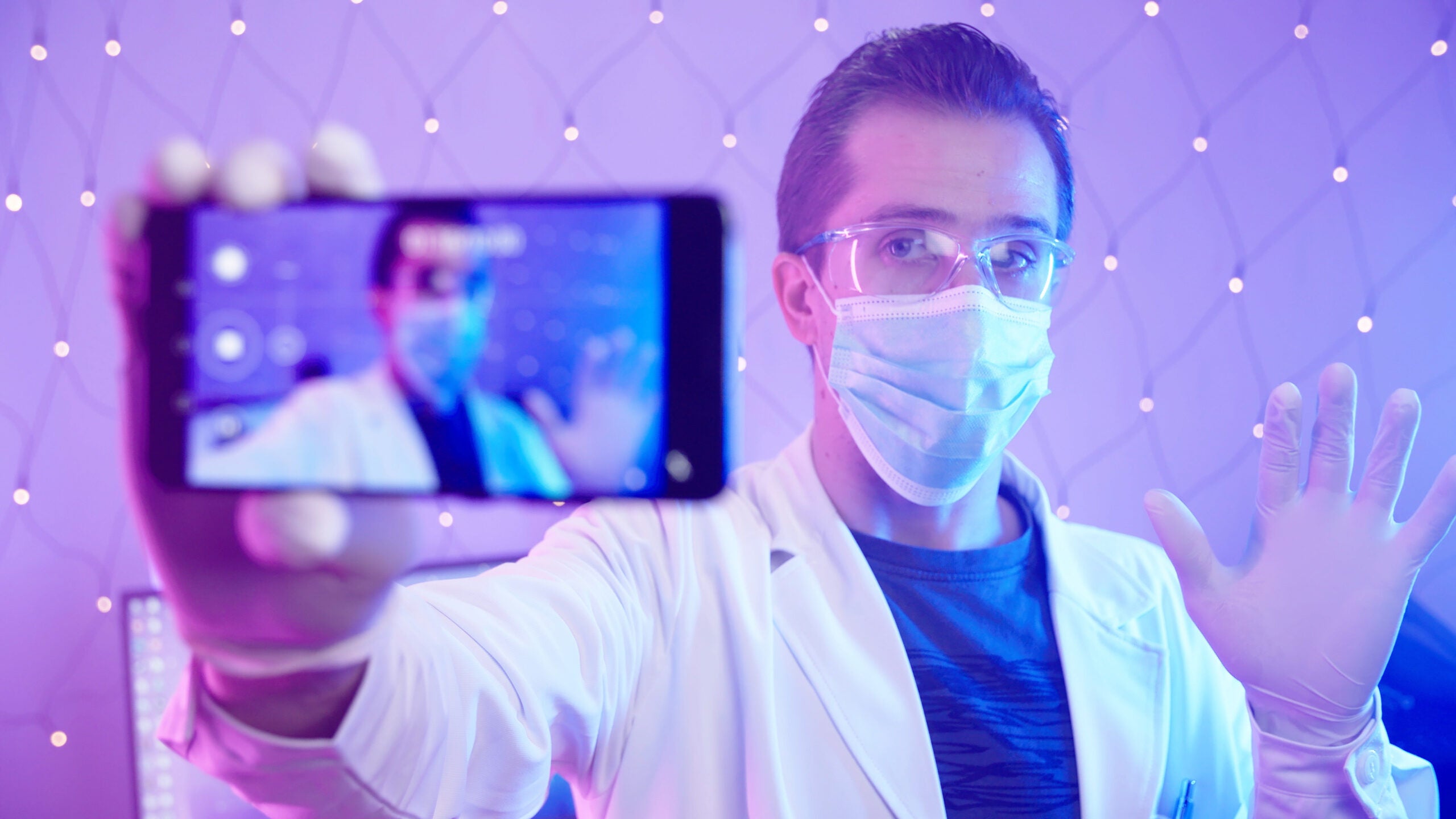
In June 2019, celebrity Jessica Biel lobbied against a pro-vaccine bill. She received intense backlash almost immediately, and the resulting scrutiny made international headlines. The exchange took place primarily on social media, where those against and those in favor of vaccines clashed—far from the first time such issues were aired loudly and publicly.
Vish Viswanath, Lee Kum Kee Professor of Health Communication and director of the Applied Risk Communication for the 21st Century program at the Harvard T.H. Chan School of Public Health, works to address this and other issues with social media and other platforms in the realm of public health. Such work focuses on the ways in which unverified information enters these popular platforms, and the impact of such information on public health. In order for public health professionals to understand how to combat these effects, they must first know the dangers of social media in relation to risk, and the effects these platforms have on large populations.
The Relationship Between Social Media and Public Health
Social media platforms are usually free and accessible, and information is not vetted as with a news source. “We always had writers and journalists as critical gatekeepers who were able to filter some of this information. But now, because of social media, we do not have this very critical intermediary,” says Viswanath. Thus, social media has been proven to facilitate the spread of false information and risk.
There are two basic types of false information that flourish:
- Misinformation, or inadvertently drawing conclusions based on wrong or incomplete facts
- Disinformation, the deliberate spread of falsehoods to promote an agenda
The two are addressed differently—misinformation can be corrected with factual information, but disinformation requires a different, more complex strategy.
Beyond public figures who use their fame to speak about subjects in which they are not experts, there are also social media influencers who spread and amplify inflammatory information through the social media megaphone. Social media can be a breeding ground for hate and intolerance around hot-button issues. Furthermore, activists can exploit fragile emotions of those impacted by the issue and provide misleading causal explanations.
“A large number of them are doing this anonymously: anonymity makes them uninhibited in expressing their opinions,” explains Viswanath. The problem is compounded by “influence bots,” anonymous, automated agents unattached to a real individual and sharing disinformation.
Treating the Source of Vaccine Misinformation
Vaccines are already a divisive topic, in part because the subject can be a very personal one. The blame, shame, and fear that can be inherent in parenthood, as well as the desire to protect one’s child, are important aspects of understanding vaccine resistance.
The now-popular myth that vaccines cause autism comes from a simple mistake that’s easy to make, according to Viswanath. “Most of us confuse correlation with causation. In general, a health care professional discovers symptoms of autism at about the same age period as when a child’s undergoing immunization. Parents are genuinely struggling to make sense of what is happening to their kids, and they latch onto the explanation that’s available to them. As a society, it’s incumbent on us to be empathetic to parents who are going through this struggle.”
Vaccine-resistant individuals have come to be known as “anti-vaxxers,” but Viswanath believes this only creates more division. “Labeling only alienates people. We should be very careful how we categorize,” he warns. In a similar way, providing purely scientific reasons for vaccinations without delving into the emotions and stories behind the reasoning is ineffective at driving change.
The Public Health Challenge of Communicating Vaccine Truth
Ironically, the vast majority of the U.S. public complies with vaccinations, but they don’t speak up—leaving influencers to fill in the blank space with false information. “There has been some complacency. If you haven’t seen polio in your life, you are not affected by it. Even if people who are against vaccinations are a very small group, they speak with a very amplified voice,” Viswanath says.
Social media platforms themselves struggle with misinformation and disinformation—stuck between trying to find and address the problem, and existing within a democratic system that tolerates different beliefs. “The people who are spreading the information are always a few steps ahead—we are always in reactive mode,” says Viswanath.
In May, Instagram announced that it would filter anti-vaccination misinformation (though they didn’t specify when they would begin doing so). However, algorithms are not yet effective at allowing legitimate discussion while also blocking misinformation and disinformation effectively. Algorithms that are too wide-ranging might stifle legitimate questions and discussions. At this stage, they can only catch the most obvious instances of misinformation and disinformation.
An Effective Social Media Communications Strategy for Public Health Professionals
There’s no magic bullet: no fail-safe, constantly successful tool that will always work against the spread of false information. “We need a multisectoral, multilevel strategy,” explains Viswanath. “We want these platforms to take this seriously and put their resources and investments to minimize the problem as much as possible.
“We also have to equip our health care providers with resources to address these issues when they come up. More critical is to educate the parents right at the beginning even before these issues come up.” Research has shown that when providers make recommendations on whether parents should vaccinate their children as a routine procedure, it helps parents feel comfortable trusting the professional. When doctors and professionals open it up for discussion, then parents can become hesitant or confused.
Understanding how vaccine resistance is reported and written about is another element of the strategy—giving voice to misinformation, even if the goal is to disprove it, can lead to more confusion. The better tactic is to starve it of oxygen, figuratively speaking, by not repeating the falsehood or giving validation to the person espousing it.
Doubling up on evidence-based, scientific communication strategies, and then tailoring the message to be most effective in each community, can be one of the most effective counterpoints to misinformation and disinformation.
“We have to work with community groups and organizations—schools, parent-teacher organizations, religious institutions—in making sure community norms include vaccinations and also counter the disinformation that is out there,” Viswanath explains. “We don’t want to wait for a crisis. And if one comes up, we want to have these relationships already in place to help.”
Highlighting the manifold vaccine successes over time can remind the public of their impact—in other words, social media can also be a useful tool to provide real, factual information. For entities and corporations responsible for conveying this, the challenge is to present the truth neutrally, positively, and without blame. In other words, “We have to tone down the rhetoric, yet be proactive in promoting immunization,” says Viswanath.
Harvard T.H. Chan School of Public Health offers Applied Risk Communication for the 21st Century , an online program designed to provide the knowledge and skills needed to design effective risk communication messages
Last Updated
Critical Risk Analysis for Our Daily Lives

Dihydrogen Monoxide: it’s found everywhere, including in our body, ice caps and the air. There’s no stopping its infiltration into our lives, and if we get too much of it, we’ll die. Sound scary? It might, until we realize that Dihydrogen Monoxide is just the chemical name for water.
Risk analysis is, at its core, a form of structured thinking developed to help grapple with the many risks that humans live with every day. The basic task is to quantify the risk of an action, examine alternatives and determine if the benefits of the action justify its costs. Its practical implications are both important and complex, because context plays an important role in risk analysis. As the quote from Paracelsus goes, “The dose makes the poison.”
Dr. James K. Hammitt, director of the Harvard Center for Risk Analysis and professor of Economics and Decision Sciences, explains. “If you call water by its chemical name, it sounds scary,” he says. “The idea that some things are risky and some things are not is an oversimplification. So, given that everything can be risky, how do we manage living in the world, and how do we set government regulations to assess risk effectively?”
Because the world is so complex, no one person can understand the nuanced details in every decision of daily life: what food to eat, medicine to take, mode of transportation to use and so on. The concept known as “rational ignorance” means that it’s rational to delegate authority to others to help make decisions and minimize the dangers in our lives.
Given that everything can be risky, how do we manage living in the world, and how do we set government regulations to assess risk effectively?
A doctor can provide guidance about medication, and a government body can potentially provide guidelines for exposure to chemical and other public safety risks. Risk analysis helps these experts make recommendations and also help a layperson make informed decisions with that knowledge.
In part, it’s the study of tradeoffs. When we take a flight, for example, there’s always a small but quantifiable risk that the plane will crash. By that logic, the potential of a violent death vastly outweighs the pleasure one might experience at one’s destination. However, the key to risk analysis is that it takes into account both consequence and probability. The probability of a plane crash is very low (much lower, in fact, than that of a car crash). Thus, risk analysis would conclude that the relative risk of taking a flight is low, despite the severity of its consequences.
In the example above, the analysis is somewhat straightforward, because the risk and results are bigger, distinctive and able to be studied separately from other effects. The difficulty of conducting risk analysis with smaller and less quantifiable risks, like coming in contact with very small doses of chemicals like aspartame or radon, is much trickier. It would be unethical to test harmful, long-term chemical impacts on humans, and anecdotal information that comes from real-world data doesn’t necessarily show cause and effect.
Every choice has inherent risks, and replacing one potential action with another also means replacing certain risks with other risks.
By studying epidemiology, researchers can follow individuals who have been exposed to particular chemicals, but sometimes effects can take years or decades to manifest. When it’s a new chemical, there’s no information available yet.
A woman who chewed gum her entire life develops breast cancer, but it’s impossible to extricate what definitively caused the cancer (was it the aspartame? Was it something else? A combination of factors?) to be able to give a formal warning. In essence, Hammitt says, “We care about risks that are too small to measure, and there’s data missing.”
Even attempts to interpret these impacts can be tricky. When a study comes out that shows a small correlation between drinking wine and a longer lifespan, those results can become skewed and overblown in the media and public eye. It’s difficult to prove or disprove that claim as objectively false, and another study might find exactly the opposite reaction. “Trying to identify good chemicals versus. bad chemicals is fundamentally impossible,” says Hammitt.
These overblown fears also don’t effectively make use of rational risk analysis. Bringing in the idea of tradeoffs, Hammitt explains that every choice has inherent risks, and replacing one potential action with another also means replacing certain risks with other risks.
There are small amounts of methylmercury in fish, but eating fish has by and large been proven healthy, so removing fish from one’s diet removes a benefit. Vehicle crashes happen regularly in the U.S., and if the government were to make the speed limit 5 mph it would reduce the likelihood of accidents, but people would no longer be able to travel great distances.
“In the area of pesticides, banning the pesticide doesn’t ban the pest. A lot of organic produce is like this—certain synthetic chemicals cannot be used, so non-synthetic chemicals like sulfur compounds are sometimes used instead,” says Hammitt. In other words, organic doesn’t mean chemical-free, and the choice to eat food means accepting some form of pesticide into one’s diet.
Thus, risk analysis in practice involves recognizing the small risks that are sometimes not measurable, keeping an eye on the bigger risks the can be assessed and thoroughly understanding the tradeoffs. Hammitt teaches experts and administrators how to apply these principles of rigorous risk analysis to their own particular environment as a part of Environmental Health Risk: Analysis and Applications at Harvard T.H. Chan School of Public Health, which is currently on hiatus.
There are small amounts of methylmercury in fish, but eating fish has by and large been proven healthy, so removing fish from one’s diet removes a benefit.
A layperson, while not responsible for setting standards, can also use a more rational and thoughtful kind of risk analysis. Hammitt references Thinking, Fast and Slow by Nobel Prize winner in economics Daniel Kahneman.
“Essentially, we have two decision-making systems. One is System 1, which is fast, intuitive and takes little effort. This is a gut decision. System 2 is cognitive, reflective and analytical. It takes work, so it’s natural not to consciously do it as much. We can be governed by System 1, so the way to improve is to use System 2 as much as you can.”
In other words, automatically rushing to identify “good” versus “bad” decisions is tempting, when the truth is more nuanced and far less easily defined. Since people can’t examine every aspect of their lives, a selective and thoughtful process of risk analysis can be effective when conditions change or new information becomes available.
Ultimately, everyone conducts risk analysis, whether consciously or not. The more that informed, thoughtful decisions can become part of one’s thought process, the more one can integrate effective risk analysis into one’s life.
Last Updated
The Need for Effective Risk Communication Strategies in Today’s Complex Information Environment

There has been growing awareness in recent years about the risks of serious injuries associated with playing football. But exactly how can organizations best communicate that risk to the people who care about this issue, such as parents of youngsters on little league teams, college football players, and professional athletes?
One common element most effective risk communication strategies share is that they are customized to meet the specific interests, concerns, and habits of the target audiences. This means that parents would require different types of messaging, as well as different distribution channels, than professional athletes to inform them about the risks football poses, according to Kasisomayajula “Vish” Viswanath, PhD, Lee Kum Kee Professor of Health Communication at the Department of Social and Behavioral Sciences, Harvard T.H. Chan School of Public Health.
Viswanath is also the program director of Applied Risk Communication for the 21st Century through the Harvard Chan School, where he educates experts and other professionals working in corporations, medicine, government, and nonprofits about the need to manage risk communication properly to achieve a variety of public health and safety goals, garner support for key issues or causes, and handle damage control or reputation management.
“Risk communication is a part of everyday life. It’s something we take for granted,” Viswanath explains. “To communicate risk effectively, we need to understand who the target audiences are and the challenges they are likely to face in assessing the risk and acting on it,” he adds.
Risk communication is a part of everyday life. It’s something we take for granted.
Navigating the Complex Information Environment
This is a tall order to fill, especially with the steady stream of information immediately available today around key issues such as public health risks, environmental concerns, and natural disasters. With the ever-broadening array of traditional, alternative, and digital outlets that exist, some of the information flowing through these channels may not be filtered for accuracy, or may not be put into the proper context for the recipients so they can act on it properly. As a result, there’s the very real danger that people may miss critical facts to guide their decision making, or may take specific actions based on misinformation, which can ultimately lead to unwanted outcomes.
That puts the onus on health professionals, business leaders, elected officials, and others to be proactive in designing effective risk communication strategies. These strategies also need to be implemented in a timely manner at the first sign of any danger that exists in order to reach the right audiences in today’s complex information environment, Viswanath says.
The Need to Develop Effective Strategies
The reality is that risk communication is essential in most sectors and industries today—both for routine situations and also in times of crisis, Viswanath points out. Therefore, professionals must be well-versed in the principles of effective risk communication so they can determine how best to apply them to their own situations and needs, amidst all of the challenges that exists.
In the current complex communication environment with a multitude of platforms, it becomes difficult to communicate risk in a controlled and coordinated way.
“At one time, we were able to communicate risk in a much more controlled fashion,” he explains. “But in the current complex communication environment with a multitude of platforms, it becomes difficult to communicate risk in a controlled and coordinated way.” This means that competing opinions can enter into the mix, making it essential for professionals to steer the people they serve around various landmines that exist to find credible sources of information. What the best sources are, and how people will access them, can vary depending on different circumstances.
Examples of Risk Communication Efforts
For example, Viswanath refers to the H1N1 flu (also referred to as Swine flu) global pandemic in 2009-2010 as an example of a crisis that required the U.S. Centers for Disease Control and Prevention (CDC) to apply emergency risk communication principles to educate Americans about the importance of taking preventative measures to avoid getting sick. The messages included encouraging people to get flu vaccines, obtain anti-viral medications at the first sign of symptoms, and stay home while sick to avoid the spread of the illness. (For more details about the CDC’s communication response to the crisis, see its website at https://www.cdc.gov/h1n1flu/cdcresponse.htm.) One striking fact is that the CDC’s efforts hinged on strategic partnerships with key public and private agencies, health care providers, and the media in order to reach a very broad audience.
Similar types of broad risk communication responses have been critical to respond to natural disasters, such as the danger Hurricane Harvey posed to the greater Houston, Texas area in the fall of 2017. With serious flooding and high winds forecast, public officials used local, state, and national news outlets and social media to advise residents in danger zones to evacuate their homes and seek shelter in safer areas.
It is essential for professionals to steer the people they serve around various landmines that exist to find credible sources of information.
“When Harvey and other hurricanes happened, people were able to take precautions to move to higher ground and shelters to protect themselves. But some people did not pay attention to the warnings and did not evacuate,” Viswanath says. In some cases of these types of natural disasters, people who initially failed to respond to evacuation orders ultimately put themselves and rescuers at increased risk when conditions because extreme.
Key Steps to Develop a Risk Communication Strategy
While every situation is different and needs a different type of response depending on the specific circumstances, there are five common elements Viswanath identifies that can serve as a good starting point for developing any applied risk communication plan.
- Prepare for the crisis and be ready for it ahead of time, regardless of what type of crisis it is or whom it will affect. Planning for various scenarios can help you be ready to act when needed, he says.
- It’s essential to know your clients or your audience and understand who they are, what they care about, and what their personal situation is. “For instance, you can’t talk about evacuating if people don’t have the means to access a car. You have to be sensitive to the conditions under which the information you share can be acted upon,” Viswanath says.
- Sometimes saying less is more. “Being measured in one’s communication of risk, especially in times of uncertainty, is especially critical,” he points out. For instance, this step can be particularly important to save face when you have to change your guidelines or recommendations midway through the process.
- Be open about what you know—and also what you don’t know. Telling people you are still waiting to find out more and will share the latest findings as they become available is important to maintain your credibility over the long term.
- It’s important to practice and learn from experience. Every situation will be different, so take the time to debrief after a crisis situation and assess what you did well and what areas you may be able to strengthen in the future.
Risk Communication is an Ongoing Process
Regardless of what type of risk you are communicating, or who your audience is that you are trying to inform, it’s important to view your risk communication efforts as an ongoing process that may shift over time but will never go away.
“Remember that risk communication is not a one-time concern,” Viswanath says. “Rather, you’ll need to continually evaluate your efforts and improve on them as you go along.”
Harvard T.H. Chan School of Public Health offers Applied Risk Communication for the 21st Century, an online program designed to provide the knowledge and skills needed to design effective risk communication messages
